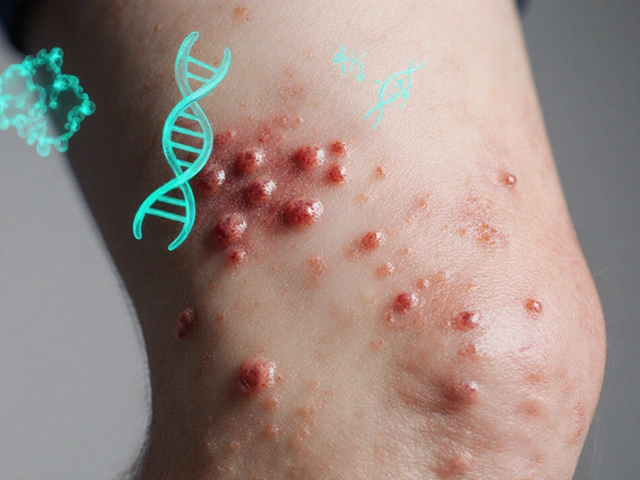When your prescription switches from the brand-name drug you’ve been taking to a generic version, it’s easy to panic. You see a different color, a different shape, maybe even a different name on the bottle. But what if that generic isn’t just any generic-it’s the exact same pill your doctor prescribed, just without the brand logo? That’s an authorized generic. And switching to one can save you $15 to $30 per prescription, with no trade-off in how well it works.
What Exactly Is an Authorized Generic?
An authorized generic is the brand-name drug, made in the same factory, with the same active and inactive ingredients, using the exact same process-but sold without the brand name on the label. It’s not a copy. It’s the original product, repackaged under a different name. The FDA requires that these be listed in the Orange Book, and manufacturers must notify the agency when they launch one.
Unlike regular generics, which must prove they’re bioequivalent through testing, authorized generics skip that step because they’re made under the original brand’s New Drug Application (NDA). That means there’s zero difference in how your body processes the medicine. If your brand drug works for you, the authorized generic will too.
Here’s the kicker: about 20-25% of brand-name drugs with generic competition now have an authorized generic version. And when they’re introduced, prices drop-sometimes by as much as 18%. In 2022, Medicare Part D data showed that 80-90% of prescriptions switched automatically to authorized generics when available, because insurance plans prefer them.
Why Do Authorized Generics Exist?
It’s not just about helping patients save money. Brand-name drugmakers introduced authorized generics as a business strategy after the 1984 Hatch-Waxman Act. That law gave the first generic company 180 days of exclusive rights to sell a generic version after a brand patent expired. But here’s the loophole: the brand company could launch its own generic at the same time, and it wouldn’t count as a competitor.
So, many brand companies did exactly that. Between 2001 and 2008, 92% of authorized generics were launched by the original brand manufacturer. The FTC found this drove down prices during that critical 180-day window-retail prices fell 4-8%, and wholesale prices dropped 7-14% compared to markets without authorized generics.
Some critics say this strategy hurts independent generic manufacturers by reducing their potential profits. But for patients? The result is clear: more affordable meds, faster.
How to Tell If You’re Getting an Authorized Generic
Not every generic is an authorized generic. Many look similar, but only some are made by the brand company itself. Here’s how to check:
- Look at the pill. If it looks identical to your brand pill-same color, same shape, same markings-it’s a strong sign.
- Check the packaging. Authorized generics won’t have the brand name on the bottle or box. Instead, you’ll see the generic name or the manufacturer’s name.
- Ask your pharmacist. They can tell you if what you’re getting is an authorized generic.
- Verify on the FDA website. The FDA updates a public list of authorized generics every quarter. Search for your drug and see if the manufacturer matches the brand’s parent company.
For example, if you take the brand-name drug Lipitor (atorvastatin), the authorized generic is made by Pfizer-the same company-and sold under the name "atorvastatin calcium" without the Lipitor logo. The pill is identical. The price? Often 70% lower.
What to Expect When You Switch
Most people notice no difference at all. Studies show medication adherence stays around 85% after switching to an authorized generic-just as high as with the brand. Hospitalization rates and discontinuation rates are statistically the same.
But some patients get tripped up by appearance changes. Even though authorized generics are made in the same facility, sometimes the packaging changes. The pill might be a different color if the brand used a proprietary coating, or the imprint might be slightly different. That doesn’t mean it’s weaker. It’s just cosmetic.
Pharmacists report that 65% of patient questions about generics are about looks-not effectiveness. So if you’re worried, ask: "Is this the same pill as before?" If the answer is yes, you’re good.

Insurance and Cost Savings
Your insurance plan doesn’t care about the brand name. It cares about cost. If an authorized generic is available, your plan will almost always require you to take it. That’s not a trick-it’s how they keep premiums low.
Here’s what you’ll likely see:
- Your copay drops from $50 to $15-$25.
- For specialty drugs, savings can hit $100+ per month.
- Some plans waive prior authorization for authorized generics because they’re considered equivalent.
Don’t assume your insurance will automatically switch you. Check your Explanation of Benefits (EOB) or call your insurer. If you’re still getting billed for the brand, ask your pharmacy to switch to the authorized version.
What to Do If Your Pharmacy Doesn’t Have It
Authorized generics aren’t always stocked right away. Sometimes, pharmacies get the regular generic first. If you want the authorized version, say so.
Ask your pharmacist: "Do you carry the authorized generic for [drug name]?" If they don’t, they can usually order it in 1-2 days. Most pharmacies have access to the FDA’s list and know which manufacturers supply authorized versions.
Pro tip: If you’re on a mail-order pharmacy, make sure your prescription is flagged for the authorized generic. Otherwise, you might get the regular generic by default.
Potential Pitfalls and How to Avoid Them
Switching is usually smooth, but here are three things to watch for:
- Confusion with regular generics: Some people think all generics are the same. They’re not. Only authorized generics are exact copies. Always verify.
- Changes in pill appearance: If your pill suddenly looks different, don’t assume it’s wrong. Check the name and manufacturer. If it’s the same as the brand’s, you’re fine.
- Insurance surprises: Rarely, a plan might not cover the authorized generic if it’s not on their formulary. Call your insurer to confirm coverage before switching.
Also, if you have allergies or sensitivities to certain dyes or fillers, double-check the inactive ingredients. Even though authorized generics match the brand exactly, it’s worth confirming-especially if you’ve had reactions before.

When Not to Switch
There are very few cases where you shouldn’t switch. If your doctor specifically prescribed the brand because of a rare medical reason-like a documented sensitivity to an inactive ingredient in a regular generic-you should stick with it. But that’s extremely uncommon.
For the vast majority of patients, authorized generics are not just safe-they’re better. They’re cheaper, just as effective, and often more reliable than traditional generics because they come from the same production line.
Final Checklist Before Switching
Before you accept the switch, run through this quick list:
- ✅ Confirm the drug is listed as an authorized generic on the FDA’s quarterly list.
- ✅ Ask your pharmacist: "Is this made by the same company as the brand?"
- ✅ Check your pill’s appearance against your last brand prescription.
- ✅ Call your insurance to verify the copay is lower.
- ✅ Tell your doctor you’ve switched-just so they know your records are updated.
If you check all these boxes, you’re set. You’ll get the same medicine, at a fraction of the cost.
What’s Next for Authorized Generics?
Authorized generics are growing fast. From 2020 to 2022, their introductions rose 22% year over year. Analysts predict they’ll be standard for 35% of biologic drugs losing patent protection by 2028. The FDA is also improving how these drugs are tracked-pharmacy systems now auto-flag authorized generics during dispensing, so you’ll know right away.
For patients, that means more transparency, more savings, and fewer surprises. The goal isn’t to replace brand drugs-it’s to give you the same medicine, at a price you can afford.
Are authorized generics as safe as brand-name drugs?
Yes. Authorized generics are made in the same facility, with the same ingredients, and under the same quality controls as the brand-name drug. The FDA requires them to be identical in strength, dosage, and performance. There is no difference in safety or effectiveness.
Why does my authorized generic look different from the brand?
Sometimes, even though the pill is made by the same company, the packaging or pill imprint may change slightly due to different labeling requirements or production batches. These are cosmetic changes only. The active ingredient and how your body absorbs it remain unchanged.
Can I ask my pharmacist to give me the authorized generic instead of the regular generic?
Absolutely. Pharmacists are required to dispense the least expensive option covered by your plan, but if you specifically request the authorized generic and it’s available, they can usually provide it. Just ask: "Is there an authorized generic for this drug?"
Do authorized generics work faster or stronger than regular generics?
No. They work exactly the same as the brand-name drug. Regular generics must prove bioequivalence, but authorized generics are the actual brand product-so they’re not just equivalent, they’re identical. Neither is stronger or faster.
Will my insurance always cover the authorized generic?
In most cases, yes. Insurance plans prefer authorized generics because they’re cheaper than the brand and often cheaper than regular generics too. But always check your plan’s formulary. If it’s not covered, your pharmacist can help you file an exception request.
How do I find out if my drug has an authorized generic?
Visit the FDA’s website and search the quarterly list of authorized generics. You can also ask your pharmacist or check the drug’s page on Drugs.com, which often lists authorized generic manufacturers. If the manufacturer matches the original brand company, it’s an authorized generic.
Switching to an authorized generic isn’t a compromise-it’s a smart upgrade. You keep the same medicine. You pay less. And you avoid the guesswork of whether a regular generic will work the same way. In a system where drug prices keep climbing, this is one of the few places you can actually save without sacrificing quality.






Comments
Jonah Thunderbolt
26/Nov/2025OMG I CRIED WHEN I SWITCHED TO THE AUTHORIZED GENERIC FOR MY CHOLESTEROL MED-SAME PILL, 70% LESS $$$ 😭💸 I literally held it up to the light like it was a diamond 💎 and cried harder when I realized it was literally the SAME THING my doctor prescribed. Brand names are just corporate glitter on a pill. We’re being scammed daily. #PharmaScam